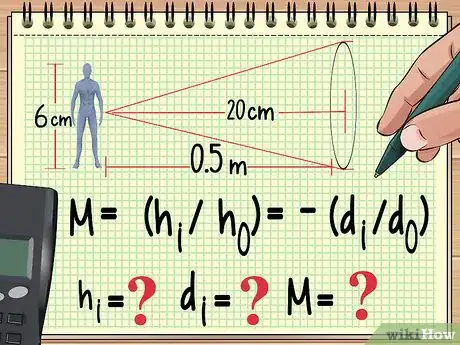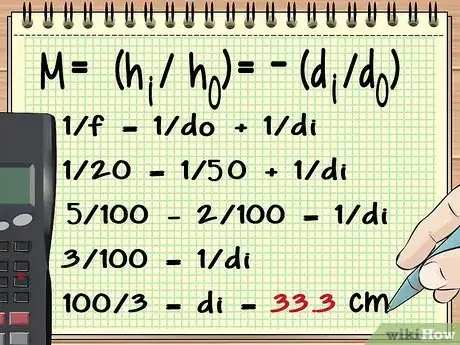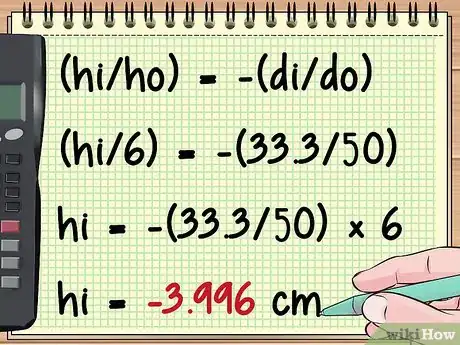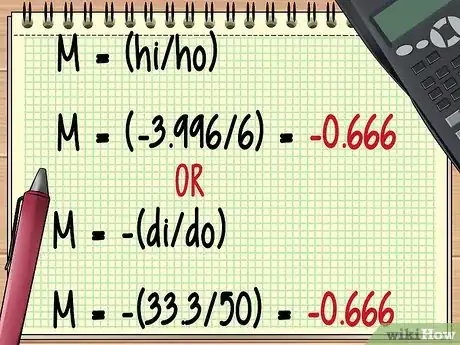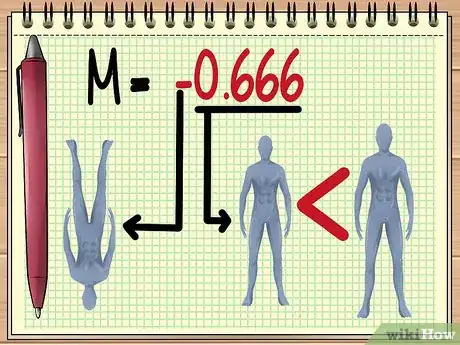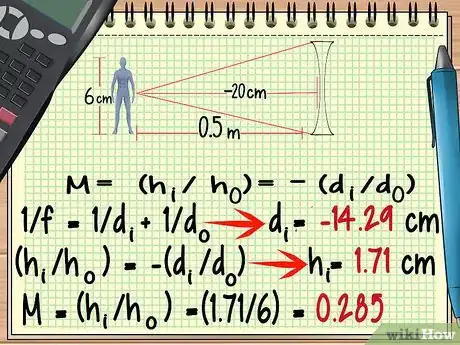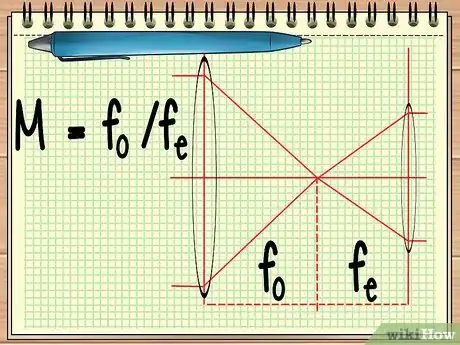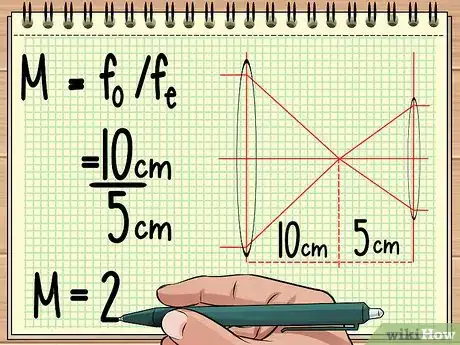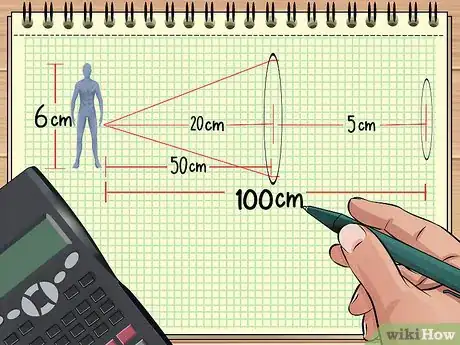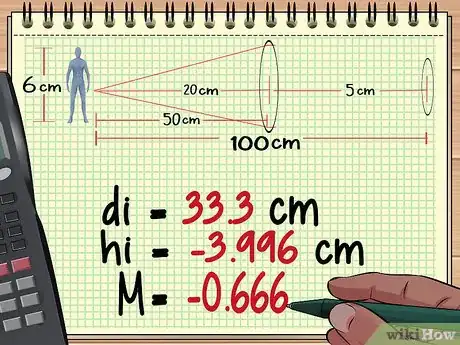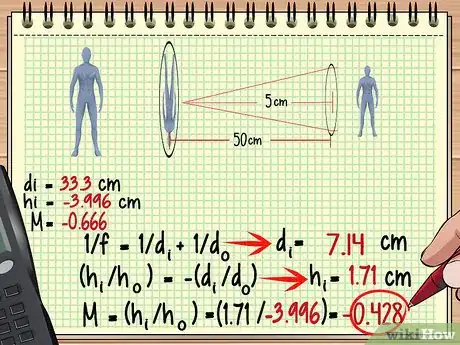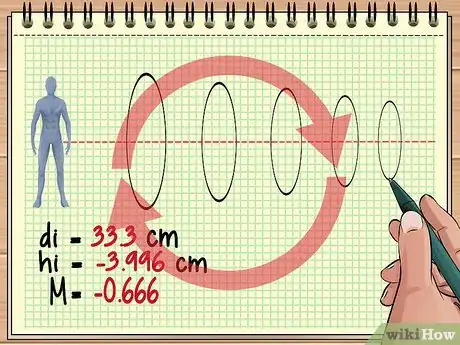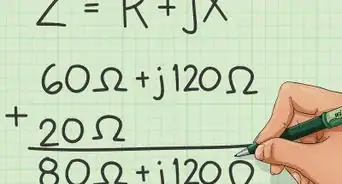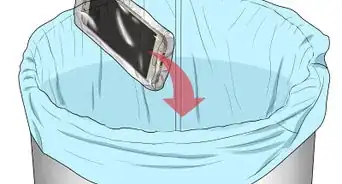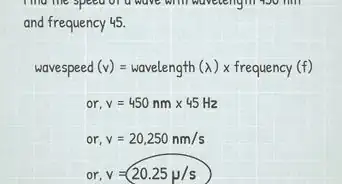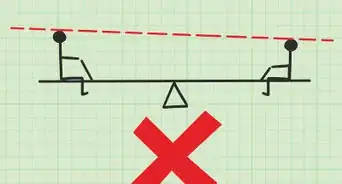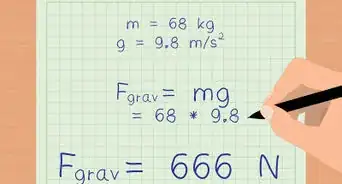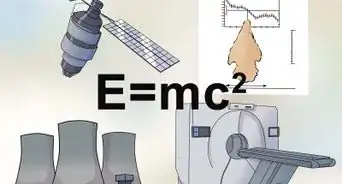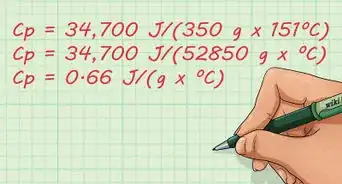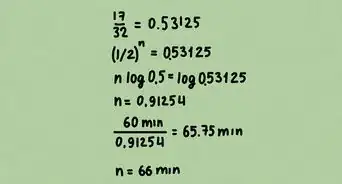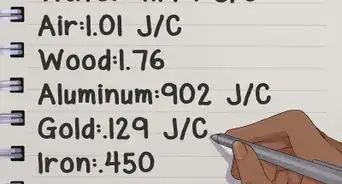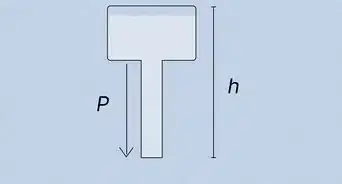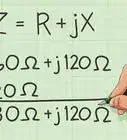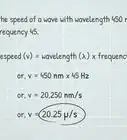wikiHow is a “wiki,” similar to Wikipedia, which means that many of our articles are co-written by multiple authors. To create this article, 12 people, some anonymous, worked to edit and improve it over time.
There are 12 references cited in this article, which can be found at the bottom of the page.
This article has been viewed 290,212 times.
Learn more...
In the science of optics, the magnification of an object like a lens is the ratio of the height of the image you can see to the height of the actual object being magnified. For instance, a lens that makes a small object appear very big has a high magnification, while a lens that makes an object appear small has a low magnification. An object's magnification is generally given by the equation M = (hi/ho) = -(di/do), where M = magnification, hi = image height, ho = object height, and di and do = image and object distance.
Steps
Finding the Magnification of a Single Lens
Note: A converging lens is wider in the middle than it is at the edges (like a magnifying glass.) A diverging lens is wider at the edges than it is in the middle (like a bowl).[1] Finding magnification is the same for both, with one important exception. Click here to go straight to the diverging lens exception.
-
1Start with your equation and determine which variables you know.[2] Like with many other physics problems, a good way to approach magnification problems is to first write the equation you need to find your answer. From here, you can work backwards to find any pieces of the equation that you need.[3]
- For example, let's say that a 6 centimeter tall action figure is placed half a meter away from a converging lens with a focal length of 20 centimeters. If we want to find the magnification, image size, and image distance, we can start by writing our equation like this:
- M = (hi/ho) = -(di/do)
- Right now, we know ho (the height of the action figure) and do (the distance of the action figure from the lens.) We also know the focal length of the lens, which isn't in this equation. We need to find hi, di, and M.
- For example, let's say that a 6 centimeter tall action figure is placed half a meter away from a converging lens with a focal length of 20 centimeters. If we want to find the magnification, image size, and image distance, we can start by writing our equation like this:
-
2Use the lens equation to get di. If you know the distance of the object you're magnifying from the lens and the focal length of the lens, finding the distance of the image is easy with the lens equation. The lens equation is 1/f = 1/do + 1/di, where f = the focal length of the lens.[4]
- In our example problem, we can use the lens equation to find di. Plug in your values for f and do and solve:
- 1/f = 1/do + 1/di
- 1/20 = 1/50 + 1/di
- 5/100 - 2/100 = 1/di
- 3/100 = 1/di
- 100/3 = di = 33.3 centimeters
- A lens's focal length is the distance from the center of the lens to the point where the rays of light converge in a focal point. If you've ever focused light through a magnifying glass to burn ants, you've seen this. In academic problems, this is often given to you. In real life, you can sometimes find this information labeled on the lens itself.[5]
Advertisement - In our example problem, we can use the lens equation to find di. Plug in your values for f and do and solve:
-
3Solve for hi. Once you know do and di, you can find the height of the magnified image and the magnification of the lens. Notice the two equals signs in the magnification equation (M = (hi/ho) = -(di/do)) — this means that all of the terms are equal to each other, so we can find M and hi in whatever order we want.[6]
- For our example problem, we can find hi like this:
- (hi/ho) = -(di/do)
- (hi/6) = -(33.3/50)
- hi = -(33.3/50) × 6
- hi = -3.996 cm
- Note that a negative height indicates that the image we see will be inverted (upside down).
- For our example problem, we can find hi like this:
-
4Solve for M. You can solve for your final variable using either -(di/do) or (hi/ho).[7]
- In our example, we would finally find M like this:
- M = (hi/ho)
- M = (-3.996/6) = -0.666
- We also get the same answer if we use our d values:
- M = -(di/do)
- M = -(33.3/50) = -0.666
- Note that magnification does not have a unit label.
- In our example, we would finally find M like this:
-
5Interpret your M value. Once you have a magnification value, you can predict several things about the image you would view through the lens. These are:
- Its size. The bigger the absolute value of the M value, the bigger the object will seem under magnification. M values between 1 and 0 indicate that the object will look smaller.
- Its orientation. Negative values indicate that the image of the object will be inverted.
- In our example, our M value of -0.666 means that, under the conditions given, the image of the action figure will appear upside down and two-thirds its normal size.
-
6For diverging lenses, use a negative focal length value. Even though diverging lenses look very different than converging lenses, you can find their magnification values using the same formulas as above. The one important exception here is that divergent lenses will have negative focal lengths. In a problem like the one above, this will affect the answer you get for di, so be sure to pay close attention.[8]
- Let's re-do the example problem above, only this time, we'll say we're using a diverging lens with a focal length of -20 centimeters. All of the other starting values are the same.
- First, we'll find di with the lens equation:
- 1/f = 1/do + 1/di
- 1/-20 = 1/50 + 1/di
- -5/100 - 2/100 = 1/di
- -7/100 = 1/di
- -100/7 = di = -14.29 centimeters
- Now we'll find hi and M with our new di value.
- (hi/ho) = -(di/do)
- (hi/6) = -(-14.29/50)
- hi = -(-14.29/50) × 6
- hi = 1.71 centimeters
- M = (hi/ho)
- M = (1.71/6) = 0.285
Finding the Magnification of Multiple Lenses in Sequence
Easy Two-Lens Method
-
1Find the focal length of both lenses. When you're dealing with a device that is made up of two lenses lined up with each other (like a telescope or one part of a pair of binoculars), all you need to know is the focal length of both lenses to find the overall magnification of the final image. This is done with the simple equation M = fo/fe.[9]
- In the equation, fo refers to the focal length of the objective lens and fe to the focal length of the eyepiece lens. The objective lens is the large lens at the end of the device, while the eyepiece lens is, as its name suggests, the small lens you put your eye next to.
-
2Plug your information into M = fo/fe. Once you have the focal lengths for both of your lenses, solving is easy — just find the ratio by dividing the objective's focal length by the eyepiece's. The answer you get will be the magnification of the device.[10]
- For example, let's say that we have a small telescope. If the focal length of the objective lens is 10 centimeters and the focal length of the eyepiece lens is 5 centimeters, the magnification is simply 10/5 = 2.
Detailed Method
-
1Find the distance between the lenses and the object. If you have two lenses lined up in front of an object, it's possible to determine the magnification of the final image if you know the distances of the lenses and objects in relation to each other, the size of the object, and the focal lengths of both lenses. Everything else can be derived.[11]
- For example, let's say that we have the same setup as in our example problem in Method 1: a six-inch action figure 50 centimeters away from a converging lens with a focal length of 20 centimeters. Now, let's put a second converging lens with a focal length of 5 centimeters 50 centimeters behind the first lens (100 centimeters away from the action figure.) In the next few steps, we'll use this information to find the magnification of the final image.
-
2Find the image distance, height, and magnification for lens one. The first part of any multi-lens problem is the same as if you were dealing with just the first lens. Starting with the lens closest to the object, use the lens equation to find the distance of the image, then use the magnification equation to find its height and magnification. Click here for a recap of single-lens problems.[12]
- From our work in Method 1 above, we know that the first lens produces an image -3.996 centimeters high, 33.3 centimeters behind the lens, and with a magnification of -0.666.
-
3Use the image from the first lens as the object for the second. Now, finding the magnification, height, and so on for the second lens is easy — just use the same techniques that you used for the first lens, only this time, use its image in place of the object. Keep in mind that the image will usually be a different distance from the second lens as the object was from the first one.[13]
- In our example, since the image is 33.3 centimeters behind the first lens, it is 50-33.3 = 16.7 centimeters in front of the second one. Let's use this and the new lens's focal length to find the second lens's image.
- 1/f = 1/do + 1/di
- 1/5 = 1/16.7 + 1/di
- 0.2 - 0.0599 = 1/di
- 0.14 = 1/di
- di = 7.14 centimeters
- Now, we can find hi and M for the second lens:
- (hi/ho) = -(di/do)
- (hi/-3.996) = -(7.14/16.7)
- hi = -(0.427) × -3.996
- hi = 1.71 centimeters
- M = (hi/ho)
- M = (1.71/-3.996) = -0.428
- In our example, since the image is 33.3 centimeters behind the first lens, it is 50-33.3 = 16.7 centimeters in front of the second one. Let's use this and the new lens's focal length to find the second lens's image.
-
4Continue on in this pattern for additional lenses. This basic approach is the same whether you have three, four, five, or a hundred lenses lined up in front of an object. For each lens, treat the image of the previous lens as its object and use the lens equation and magnification equation to find your answers.[14]
- Keep in mind that subsequent lenses can continue to invert your image. For instance, the magnification value we got above (-0.428) indicates that the image we see will be about 4/10 the size of the image from the first lens, but right side up, since the image from the first lens was upside down.
Community Q&A
-
QuestionWhat does it mean when a magnifying glass is 100mm - 5x?
 DonaganTop AnswererIts diameter is 100 mm, and it makes objects appear to be five times their actual size.
DonaganTop AnswererIts diameter is 100 mm, and it makes objects appear to be five times their actual size. -
QuestionHow does percent magnification convert to x times magnification?
 DonaganTop Answerer100% magnification equals 2x magnification. 200% = 3x. 300% = 4x, and so forth.
DonaganTop Answerer100% magnification equals 2x magnification. 200% = 3x. 300% = 4x, and so forth. -
QuestionShould I look at the sign on the value of magnification to know if the image is larger than the object?
 Community AnswerNo, the sign is related to whether the image is (-) or isn't (+) inverted in relation to the object. You know that the image is larger if the value is bigger than one M > 1.
Community AnswerNo, the sign is related to whether the image is (-) or isn't (+) inverted in relation to the object. You know that the image is larger if the value is bigger than one M > 1.
References
- ↑ https://www.bbc.com/bitesize/guides/zt42srd/revision/1
- ↑ https://sciencing.com/forms-magnification-equations-7490609.html
- ↑ https://www.bbc.com/bitesize/guides/zt7srwx/revision/3
- ↑ https://www.physicsclassroom.com/class/refrn/Lesson-5/The-Mathematics-of-Lenses
- ↑ http://www.nikonusa.com/en/Learn-And-Explore/Article/g3cu6o2o/understanding-focal-length.html
- ↑ https://www.physicsclassroom.com/class/refln/Lesson-3/The-Mirror-Equation
- ↑ https://sciencing.com/forms-magnification-equations-7490609.html
- ↑ http://physics.bu.edu/py106/notes/Lenses.html
- ↑ http://www.rocketmime.com/astronomy/Telescope/Magnification.html
- ↑ http://www.livephysics.com/problems-and-answers/optics/lens-system-image-distance-magnification/
- ↑ https://www.khanacademy.org/science/physics/geometric-optics/lenses/v/multiple-lens-systems
- ↑ https://www.plymouth.ac.uk/uploads/production/document/path/3/3754/PlymouthUniversity_MathsandStats_outreach_lenses.pdf
- ↑ http://www.physics.purdue.edu/~jones105/phys42200_Spring2013/notes/Phys42200_Lecture31.pdf
- ↑ https://www.plymouth.ac.uk/uploads/production/document/path/3/3754/PlymouthUniversity_MathsandStats_outreach_lenses.pdf
About This Article
To calculate magnification, use the following formula: magnification = the height of the image ÷ by the height of the object. Plug your data into the formula and solve. If your answer is greater than 1, that means the image is magnified. If your answer is between 0 and 1, the image is smaller than the object. Finally, if your answer is negative, that means the image is upside down. Keep reading to learn how to calculate magnification when you're looking through multiple lenses!
